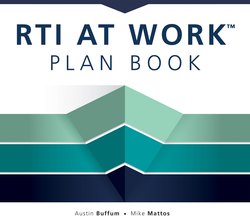Читать книгу RTI at Work™ Plan Book - Austin Buffum - Страница 6
ОглавлениеTHE RTI AT WORK™ PLAN BOOK
With a respectful nod to Jane Austen, we designed this plan book around the following assumption: It is a truth universally acknowledged that a single teacher in possession of struggling students must be in want of effective interventions.
An equally important correlate to this universal truth is that a single teacher—working in isolation—cannot single-handedly acquire and implement all of the interventions needed to ensure every student’s success. Undoubtedly, meeting the diverse needs of students requires a collaborative, systemic approach. Fortunately, when it comes to creating such a system, the research and evidence in our field have never been more conclusive—response to intervention (RTI) is the right way to intervene. Also known as a multitiered system of supports (MTSS), RTI creates a systematic process to ensure every student receives the additional time and support needed to learn at high levels. Equally important, educators can use this student-focused support to extend student learning, providing benefits to all students.
Based on his meta-analysis of more than eighty thousand studies relating to the factors inside and outside of school that impact student learning, researcher John Hattie finds that RTI ranks in the top-five educational practices proven to best increase student achievement. When implemented well, RTI has an exceptional average yearly impact rate of 1.27 standard deviation (Hattie, 2009). This deviation (often referred to as effect size) measures the efficacy of an intervention or change in practice relative to taking no interventive action at all. To put this number in perspective, consider the following.
▶ A 1.0 standard deviation increase is typically associated with advancing student achievement two to three years (Hattie, 2009).
▶ Based on longitudinal studies, the yearly typical impact rate of a classroom teacher’s instruction ranges between 0.15 and 0.40 standard deviation growth (Hattie, 2009). This means a school that successfully implements RTI leverages a process that is considerably more effective than a school that leaves it up to individual, isolated teachers to meet students’ instructional needs.
▶ The greatest home or environmental factor that impacts student learning is a family’s economic status. Students who come from more affluent homes—defined as middle class or higher—gain a yearly academic benefit of 0.57 standard deviation growth per year (Hattie, 2009). RTI’s impact rate is more than twice as powerful as what some students might receive at home each night.
At a time in which failure in the K–12 system has lifelong implications for students, successfully harnessing the proven impact of RTI is critical for educators truly committed to ensuring every student succeeds.
We call our process RTI at Work because the guiding principles of the PLC at Work process form the foundation of our intervention recommendations. So, our best hope to help that single teacher with struggling students in want of effective interventions is to ensure that each teacher is part of a high-performing team within a school functioning as a PLC that is also committed to RTI practices.
Because ensuring every student’s success requires effective teaching and high levels of collaboration, we designed this plan book to support both instructional practices and collaboration. While most plan books guide the individual classroom teacher in instructional decisions, this RTI at Work Plan Book also guides the collaborative team planning and processes essential to schools that operate as PLCs. Most important, this plan book calls on teachers to go far beyond the traditional questions of teaching to a relentless focus on learning—for both students and educators.
To get the most out of this resource, it is important to have a clear understanding of RTI, PLC at Work, and how teacher teams drive both processes. To that end, the first part of the RTI at Work Plan Book contains an overview of the big ideas that shape RTI at Work, cultural shifts you should expect in a PLC, and keys to building high-performing collaborative teams. It also includes forms to help you work with your team more effectively as well as the standard forms you need to collect and organize information about your students and your classes. You can also visit go.SolutionTree.com/RTIatWork to access additional online resources. The second part includes forty weeks of planning pages with text and activities to inform, inspire, and challenge you and your teammates as you implement RTI at Work. You’ll also learn from other schools and districts that have embarked on the same work. The third part provides references and resources for further study.
